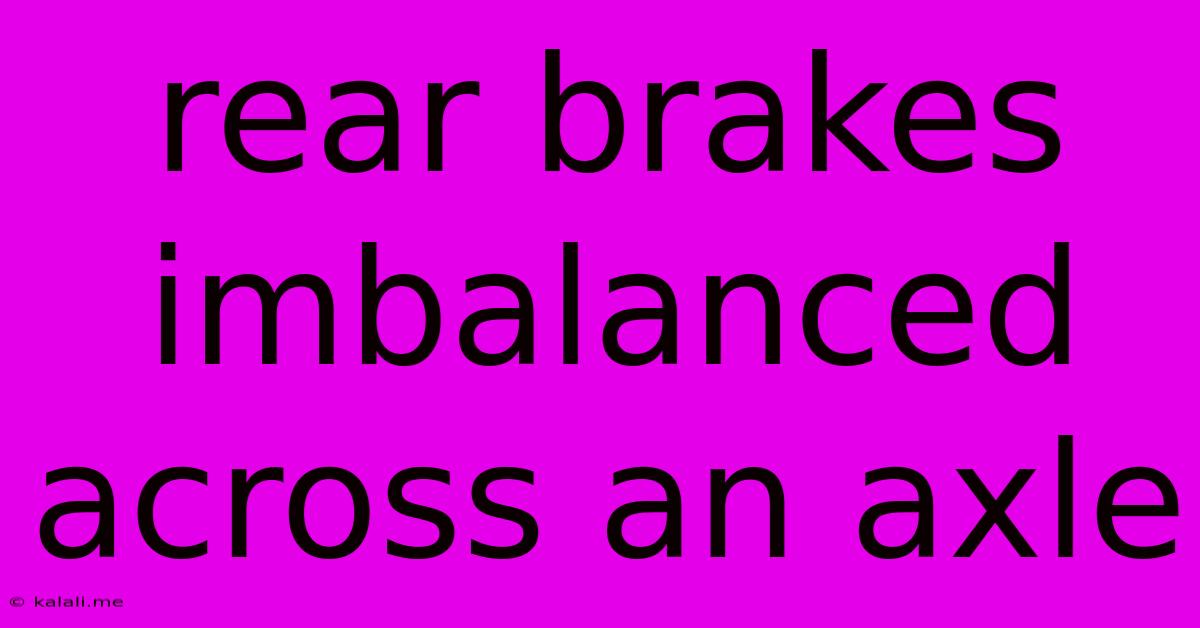Rear Brakes Imbalanced Across An Axle
Kalali
May 19, 2025 · 4 min read

Table of Contents
Rear Brakes Imbalanced Across an Axle: Diagnosis and Solutions
Meta Description: Experiencing uneven braking from your rear axle? This comprehensive guide details the causes of rear brake imbalance, diagnostic steps, and effective repair solutions, ensuring safe and efficient braking performance.
Uneven braking from the rear axle is a serious safety concern. If one rear brake is applying significantly more or less force than the other, it can lead to unpredictable handling, especially during emergency braking or in slippery conditions. This article delves into the common causes of rear brake imbalance, provides clear diagnostic steps, and outlines potential solutions. Understanding these issues is crucial for maintaining your vehicle's safety and ensuring optimal braking performance.
Common Causes of Rear Brake Imbalance
Several factors can contribute to imbalanced rear brakes. These include:
-
Uneven Brake Pad Wear: This is often the most common culprit. Differences in pad thickness between the left and right sides result in unequal braking force. Several factors contribute to uneven wear, including:
- Sticking caliper piston: A piston that doesn't retract fully allows the brake pad to remain in contact with the rotor, leading to premature wear.
- Seized caliper slide pins: Similar to a sticking piston, seized slide pins prevent the caliper from moving freely, causing uneven pressure on the pads.
- Contaminated brake fluid: Moisture or other contaminants in the brake fluid can affect the caliper's operation.
- Worn or damaged brake rotors: Warped or unevenly worn rotors can also contribute to uneven pad wear and braking imbalance.
-
Hydraulic System Issues: Problems within the hydraulic brake system can also lead to imbalanced braking. This could involve:
- Leaking brake lines or hoses: A leak in one side of the rear brake line will reduce the hydraulic pressure to that brake, causing a braking imbalance.
- Blocked brake lines: A blockage will similarly reduce the pressure to the affected brake.
- Faulty proportioning valve: In vehicles equipped with a proportioning valve, a malfunction can cause an uneven distribution of braking force between the front and rear axles, or even between the left and right rear wheels.
-
Parking Brake Issues: A partially engaged or malfunctioning parking brake can also manifest as rear brake imbalance, particularly noticeable at low speeds.
Diagnosing Rear Brake Imbalance
Accurate diagnosis is crucial for effective repair. Here's a step-by-step approach:
-
Visual Inspection: Begin by visually inspecting the brake calipers, pads, rotors, and brake lines for any obvious signs of damage, wear, leaks, or corrosion. Pay close attention to the brake pad thickness on both sides.
-
Brake Pad Thickness Measurement: Use a caliper to accurately measure the thickness of the brake pads on both the left and right rear wheels. Significant differences indicate uneven wear.
-
Brake Rotor Inspection: Check the brake rotors for uneven wear, scoring, or warping. A warped rotor can create a pulsing or vibration feeling during braking.
-
Brake Line Inspection: Carefully examine the brake lines and hoses for any signs of leakage, damage, or kinks.
-
Road Test: Conduct a road test and pay close attention to the braking feel. Note any pulling or swerving during braking, which strongly suggests imbalance.
-
Pressure Test (Advanced): A pressure test of the brake system can pinpoint hydraulic issues, such as leaks or blockages. This requires specialized equipment and is best left to a professional mechanic.
Repairing Rear Brake Imbalance
The repair will depend on the root cause identified during diagnosis. Common repairs include:
- Replacing brake pads: Replace worn or uneven brake pads with new ones of the correct specification.
- Replacing brake rotors: Replace damaged or warped rotors.
- Repairing or replacing calipers: Address sticking caliper pistons or seized slide pins by cleaning, lubricating, or replacing the affected components.
- Repairing or replacing brake lines/hoses: Repair or replace any damaged or leaking brake lines or hoses.
- Repairing or replacing the proportioning valve: Repair or replace a malfunctioning proportioning valve.
- Addressing parking brake issues: Adjust or repair the parking brake mechanism.
Remember, if you're not comfortable performing these repairs yourself, consult a qualified mechanic. Improper brake repair can be extremely dangerous.
Preventing Rear Brake Imbalance
Regular brake maintenance is key to preventing imbalance. This includes:
- Regular brake inspections: Visually inspect your brakes during routine maintenance checks.
- Promptly addressing any issues: Don't ignore any signs of brake problems.
- Using high-quality brake parts: Opt for reputable brake pad and rotor brands.
- Proper bleeding of the brake system: Ensure the brake system is properly bled after any repair work.
Addressing rear brake imbalance promptly is crucial for safety and vehicle handling. By understanding the common causes, employing the diagnostic steps outlined, and performing the necessary repairs, you can restore balanced braking performance and ensure safe driving.
Latest Posts
Latest Posts
-
What Is Wheat Flour In Uk
May 19, 2025
-
How Long To Defrost A Pork Joint
May 19, 2025
-
Can You Use Water For Antifreeze
May 19, 2025
-
Can You Use Water As Antifreeze
May 19, 2025
-
You Re Welcome Or Your Welcome
May 19, 2025
Related Post
Thank you for visiting our website which covers about Rear Brakes Imbalanced Across An Axle . We hope the information provided has been useful to you. Feel free to contact us if you have any questions or need further assistance. See you next time and don't miss to bookmark.